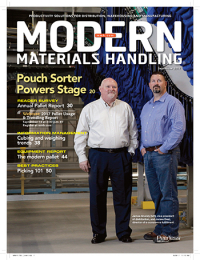Warehouse Basics: Navigating the pick path
No picking technology can do everything, so it’s important to let the profiles of SKUs and orders pick the right solution.
Welcome to Warehouse Basics, a five-part series in which Modern will unpack the essential elements of functional areas in the warehouse. Informed by industry experts, these articles are intended to capture a snapshot of the current state of materials handling practices. So far, we’ve moved from receiving through putaway, storage and replenishment. We now turn to picking before the final entry on packing and shipping is published in the October issue.
Picking is a rapidly evolving, hugely diverse function in the warehouse, and one story cannot possibly encapsulate it all. Instead, this article will divide the discussion into the fundamentals of less-than-case and more-than-case picking methodologies.
The universal trend in all applications of picking technology in the warehouse, whether for picking pallets, cases or pieces is: There is no single general approach that will meet all needs. No pick module, automated storage and retrieval system (AS/RS), multi-shuttle, storage system, employee or equipment can handle all products.
Not long ago, inside any given building, picking was pretty much the same. Maybe there was one area for slow-movers and one for everything else. But, the modern warehouse demands the intelligent application of technology by product type, order type and product velocity, among other considerations. In recent years, it’s increasingly common to see three or four technologies blended together to allow a single building to assemble an entire order. Success requires a thorough understanding of order profiles by each segment of the SKU population, allowing for the selection of the most productive and efficient solutions for each.
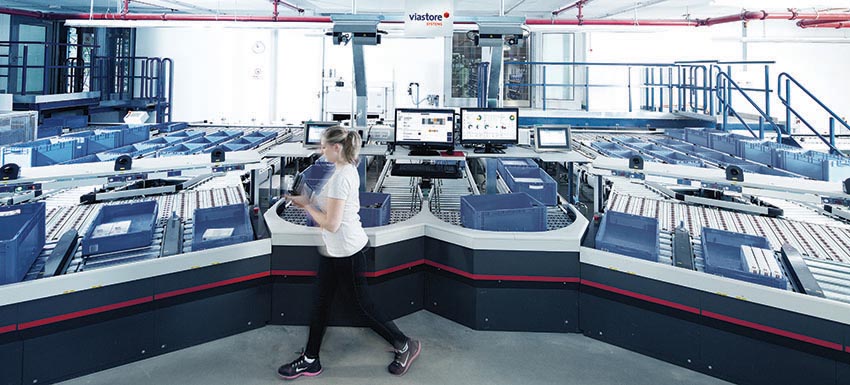
Full pallets
Products handled in full pallet quantities tend to be commodities like paper towels, for example. Pallet picking generally involves a lift truck going into storage, removing a full unit load and delivering it to the dock. At the dock, the pallet might receive a shipping label or other validation, but sophisticated operations allow the forklift operator to scan a license plate on the pallet, take it to the dock and drop it directly onto a 53-foot trailer.
Full pallet handling is the simplest form of picking. It can be accomplished with a conventional forklift, or a man-up turret truck in a narrow aisle environment, or by an AS/RS pulling a full unit load out of storage and delivering it to an interface at the end of the AS/RS. In the most highly automated, zero-touch applications, the system might even be able to deliver from the AS/RS to an automatic truck loading system. Lights-out systems for full pallet handling are rare since such automation in an ambient warehouse would require a significant amount of labor savings to justify. It is more common in areas with high real estate and labor costs like Europe.
Full pallet shipping in general has diminished in recent years. To achieve just-in-time shipping or increased inventory turns, everyone is buying in smaller, more frequent quantities whenever possible, which drives less full-pallet picking. Another driver is SKU proliferation. A maker of only vanilla and chocolate pudding will ship plenty of full pallets of each, but when another dozen flavors are added to the mix, the retail store does not sell 12 times as much pudding.
Peeling back the layers
As the industry transitions away from full pallet shipping, it faces rising labor costs because transferring pallet layers is strenuous and inefficient. The growth of layer shipping has given rise to new forms of automation and mechanization that did not exist decades ago. More applications led to increased research and development in layer-picking technologies, a few of which had been used in manufacturing applications to build single-SKU pallets. As new technologies joined the familiar ones, new applications emerged for layer picking.
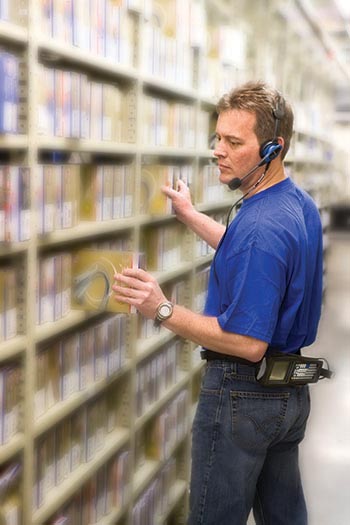 As one of the markets hardest hit by SKU proliferation, beverage companies were among the earliest adopters of layer picking. It’s now common to see manufacturers building multi-SKU layered pallets, which are often called rainbow pallets. In the case of beverages, such pallets were initially built for route delivery trucks to ensure a diverse product mix when restocking shelves. Rainbow pallets might also be configured for the retail store and shipped there directly from the manufacturer or crossdocked at the DC.
As one of the markets hardest hit by SKU proliferation, beverage companies were among the earliest adopters of layer picking. It’s now common to see manufacturers building multi-SKU layered pallets, which are often called rainbow pallets. In the case of beverages, such pallets were initially built for route delivery trucks to ensure a diverse product mix when restocking shelves. Rainbow pallets might also be configured for the retail store and shipped there directly from the manufacturer or crossdocked at the DC.
Inside the DC, layer-picking technologies might convey a full pallet to a robot or other device that extracts layers. To prevent the repeated movement of a pallet in and out of storage, it is ideal to fully deplete a retrieved pallet, which requires a system capable of depositing layers to multiple order pallets. There are also rare instances of automated systems designed to store and retrieve discrete layers. Layer-picking forklift attachments are much more common, using side clamps and sometimes suction to pick one or more layers at a time.
Case by case
Next we look at case picking, the retrieval of one or more cases to build a mixed pallet, or, in some instances, floor-loading a trailer with mixed cases for delivery to a customer. There is a spectrum of possibilities for how to assemble a mixed pallet. At the most basic, a picker walks with a pick list and hand jack down a conventional warehouse aisle, stopping at floor-level locations to pick one or more cases and manually stack them.
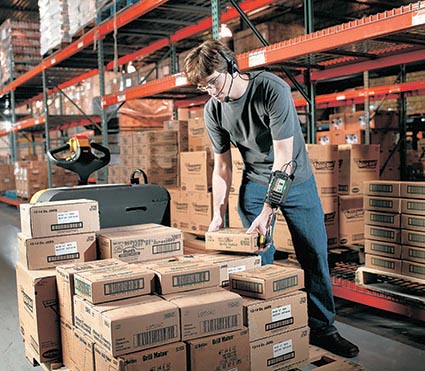 As covered in the putaway and storage entry of this series, an efficient picking process in these environments is heavily dependent on slotting. The goal is to shorten as much as possible the distance between each pick while grouping fast-moving products in easily accessible areas closest to the dock. There is a delicate balance between optimizing pick paths and avoiding congestion, which might entail multiple pick locations in multiple aisles for fast-movers. Velocity-based slotting is essential to productively picking in a manual, walking case pick environment.
As covered in the putaway and storage entry of this series, an efficient picking process in these environments is heavily dependent on slotting. The goal is to shorten as much as possible the distance between each pick while grouping fast-moving products in easily accessible areas closest to the dock. There is a delicate balance between optimizing pick paths and avoiding congestion, which might entail multiple pick locations in multiple aisles for fast-movers. Velocity-based slotting is essential to productively picking in a manual, walking case pick environment.
Once complete, the mixed pallet is delivered to the shipping dock, where it is typically wrapped to ensure the stability of a unit load assembled from irregular case sizes. Although slotting for velocity is an important consideration, slotting should also promote a stable pallet build as the picker walks the pick path. Placing heavy items on crushable items or larger items on smaller ones jeopardizes productivity, product quality and employee safety. Although slotting can help ensure a stable unit load, it is important to recognize that the picker must bring a certain amount of skill to the process.
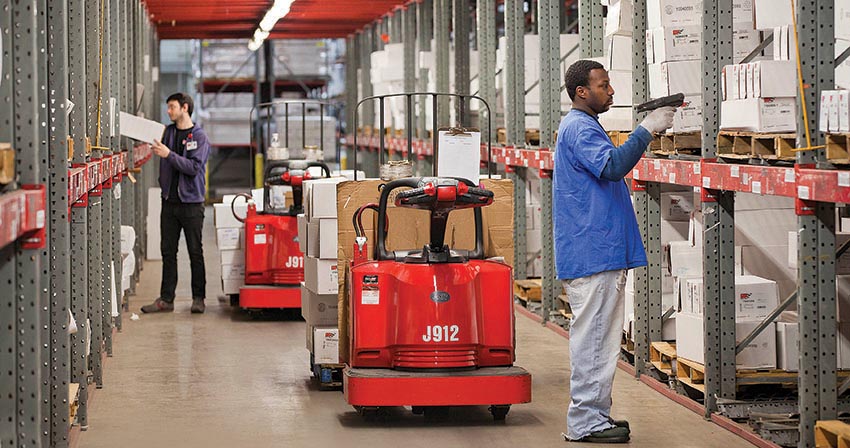
Automation applications
Operations with enough volume and labor might invest in mechanized picking technologies. One of the most common applications is a walk pick line with a central conveyor flanked by pick locations and pickers on either side. Pickers deposit cases onto a conveyor, which takes them away to be sorted. Such setups are commonly multi-level pick modules, with serpentine conveyors running from level to level. Pallets are fed from the back side of each pick location, leaving about 30 inches between the conveyor edge and the pallet’s pick face.
The pick module requires labels for each picked case so a sortation system can read them and ensure cases are routed to the correct order and divert lane. Carton labels are usually intended to enable automatic conveying and sortation, but if generated in the order of the optimal pick path, they can also replace a conventional pick list. Carton labels are sometimes used in non-mechanized walk pick environments, but unless a customer has specifically requested a label per case or stringent auditing is required, it is not always worthwhile to label every case. That said, a UCC 128 label can sometimes serve as an outbound shipping label as well.
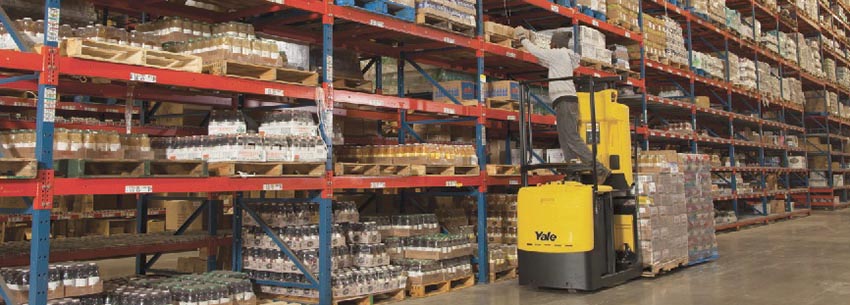
Each location in a pick module might hold just one pallet or multiple in a pallet flow lane. A limitation of single-deep lanes is that a new pallet must be replenished—some systems use forklifts, others an AS/RS—immediately after the old one is exhausted. That said, even lanes that go three deep are not ideal for a product ordered in a huge quantity across the customer base.
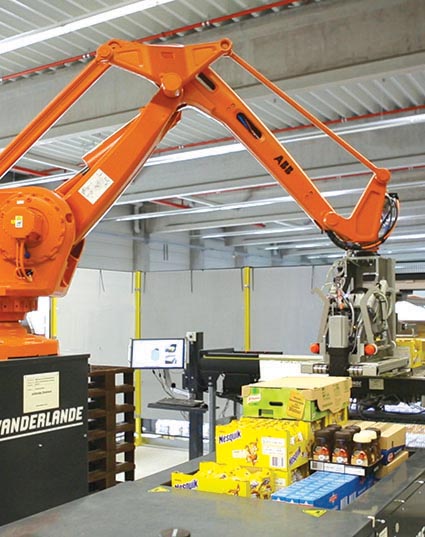 For example, say the module supplies 15 grocery store DCs. On any given day, those DCs might demand a combined 12 pallets of a certain product, but none of them ordered a full pallet. A three-deep lane would require four replenishments per day, and multiple three-deep lanes isn’t much more efficient. In that case, a simpler alternative to case picking that product within the module is to set up what’s known as a “slapper” line. The dozen full pallets of the product are sent to that line throughout the day, where cases are labeled and fed onto the conveyor, but there is no dedicated pick face within the module for that product. Tomorrow, the slapper line might be filled with a different SKU depending on the fast-mover of the day. This avoids the capital expense of dedicated pick faces for products that may or may not move at extremely high volumes.
For example, say the module supplies 15 grocery store DCs. On any given day, those DCs might demand a combined 12 pallets of a certain product, but none of them ordered a full pallet. A three-deep lane would require four replenishments per day, and multiple three-deep lanes isn’t much more efficient. In that case, a simpler alternative to case picking that product within the module is to set up what’s known as a “slapper” line. The dozen full pallets of the product are sent to that line throughout the day, where cases are labeled and fed onto the conveyor, but there is no dedicated pick face within the module for that product. Tomorrow, the slapper line might be filled with a different SKU depending on the fast-mover of the day. This avoids the capital expense of dedicated pick faces for products that may or may not move at extremely high volumes.
Slow-movers, on the other hand, also don’t belong in the pick module, and might instead be housed in an aisle where a picker walks at ground level. If the total demand for an entire aisle of slow-movers is less than a pallet or so, it is often ideal to use an orderpicker forklift to pick at height from multiple levels.
Once conveyed, sorted and diverted, cases are then typically palletized either manually or automatically. For floor-loaded shipments, the divert lane might include conveyors that extend directly into the truck. At this point cases are largely removed by hand, although robotic solutions have been recently developed to densely and securely stack cases.
Revisiting the module
As the number of SKUs increases, there is more demand for locations in the pick module and more fast- and slow-movers that aren’t suited to the module. Where three-deep pallet lanes were once ideal, a single-deep configuration starts to gain an edge. Although technically possible, few pick modules are retrofitted to adapt to this change. It might make sense to add case flow lanes to the module’s pick line to help fit more SKUs, which is sometimes worth the increase in replenishment labor. More commonly, modules struggling to keep up with SKU proliferation are replaced altogether.
Single-deep modules replenished by an AS/RS are an effective way to ensure pallets can be rapidly fed to depleted locations. An AS/RS can also help uncouple SKUs from dedicated positions, preserving the freedom to dynamically slot according to each SKU’s changes in volume. This requires a system capable of batching orders in such a way that not every SKU is needed in every wave.
A final note on case picking: A set of emerging technologies are designed to store, retrieve and transport single cases to a stationary picker. These systems are sometimes intended to make the case available for broken case picking, but are also being used to retrieve cases that are shippable units. Ten years ago, automatic full case picking was a novel if impractical concept, and typically took the form of full pallet retrieval and robotic case picking. The new devices will take one or more cases of a SKU from storage and carry them forward to an operator.
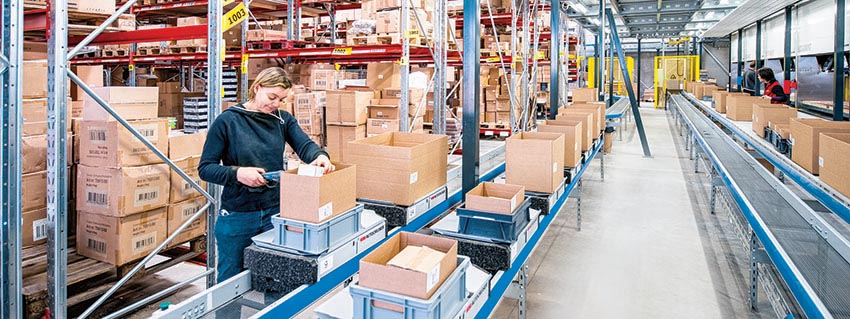
Cracking the case
The simplest form of broken case picking is quite similar to the basic case pick setup described above, with a picker walking from one pick face to another. However, instead of full pallet quantities at each location, product tends to be stored in bins, shelving or carton flow racks. Anyone familiar with grocery shopping has a good idea how to perform piece-pick order assembly.
Not every fulfillment center processes the volume required to justify investment in automated piece-picking solutions. In low-labor environments, it is essential to slot intelligently, both in terms of pick paths (the number of steps needed) and the size of each pick face (the number of accessible pick locations per each step taken). Batching is also particularly effective. A picker using a cart or put wall configured for 20 orders could potentially exhaust an entire case of 20 items without having to travel to—or wait for—the next pick.
The Pareto principle suggests that 80% of volume will come from 20% of SKUs, but if demand is more evenly spread across SKUs, you’ll have to devise creative ways to shorten pick paths. It could make sense to move product to a stationary area for assembly into the shipping carton or move the shipping carton—rather than the picker—from aisle to aisle. Cartons might trace a serpentine path through an entire facility, or zone-divert versions of this setup will bypass those aisles without items needed for the order. Customer service levels are also an important consideration, and zone diverting can help achieve shorter cycle times and increased responsiveness. In addition to labor savings, this can create value from throughput if customers are willing to pay a premium to get an order faster.
Whether a picker walks through a facility, stays in a dedicated 50-SKU zone, or picks from totes delivered by a multi-shuttle or vertical carousel, the goal is the same: Any technologies, system enhancements and process improvements that enable broken case picking must reduce the cycle time between one pick and the next. By this rule, it is not enough to reduce walking, because a stationary picker waiting for the next pick is just as inefficient. A zone picker will not have to travel far, but the system must be set up to ensure each zone has enough work to keep its picker busy. Ironically, in such scenarios it is more effective to spread fast- and slow-movers throughout zones rather than group them in such a way that could overburden one zone while depriving another. Or, it might be ideal to establish a walk pick area for slow-movers and a zone-divert system for fast-movers.
As a supplement or substitute for zone-divert systems, AS/RS systems for piece picking can help address SKU proliferation. Such systems might store items in case quantities so a picker can open them or might have pieces decanted into totes or bins. A system might also move discrete totes and bins, or it could transport shelving with multiple SKUs to a stationary picker. Multi-shuttles, mobile robots and even a well-slotted mini-load system can be equally productive from a labor standpoint—provided the picker is kept continuously busy. The sophistication of the system’s software will be the determining factor for productivity.
Although they will save labor, automated systems also add maintenance responsibilities to ensure optimal uptime, and algorithms must be routinely updated to reflect shifting order and SKU profiles. There is no automated system that operates on a “set it and forget it” principle. The process of identifying and rearranging SKUs that have seen a velocity uptick or slowdown is a science all its own. It is possible to make such decisions based on order history, but these determinations will always be backward-looking. Predictive and proactive adjustments are preferable whenever possible.

Article Topics
Columns News & Resources
New resource center for weighing and dimensioning Protective packaging roundup MODEX C-Suite Q&A: Troy Donnelly, Senior VP of Sales, Marketing, and Application, DMW&H When Just-in-Time Just Doesn’t Work Recycling coastline plastic into premium reusable packaging Fresh food, anyone? RPCs protect in the supply chain Why Isn’t Your Loading Dock Connected to Your Supply Chain? More ColumnsLatest in Materials Handling
Materials Handling Robotics: The new world of heterogeneous robotic integration Lucas Watson appointed CSO for Körber’s Parcel Logistics business in North America Hyster recognizes Dealers of Distinction for 2023 Carolina Handling names Joe Perkins as COO C-suite Interview with Keith Moore, CEO, AutoScheduler.AI: MODEX was a meeting place for innovation Walmart deploying autonomous lift trucks at four of its high-tech DCs Coles shops big for automation More Materials HandlingAbout the Author
Subscribe to Materials Handling Magazine

Find out what the world's most innovative companies are doing to improve productivity in their plants and distribution centers.
Start your FREE subscription today.
April 2024 Modern Materials Handling

Latest Resources



